Kaohsiung Rapid Transit
The Kaohsiung Rapid Transit System (Chinese: 高雄大眾捷運系統, 高雄捷運)[1] is a rapid transit and light rail system covering the metropolitan area of Kaohsiung, Taiwan. The metro system is commonly known as Kaohsiung MRT for "mass rapid transit". Construction of the MRT started in October 2001.[4] The MRT opened in 2008 and the Circular light rail in 2015.[5][6][7] KRTS is operated by the Kaohsiung Rapid Transit Corporation (KRTC; Chinese: 高雄捷運公司) under a BOT contract the company signed with the Kaohsiung City Government.
.svg.png.webp) Logo | |
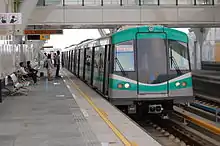 | |
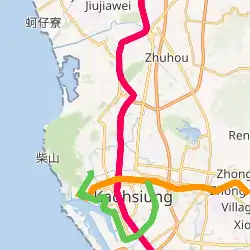
KMRT Route map | |
| Overview | |
|---|---|
| Owner | Kaohsiung City Government[lower-alpha 1] |
| Locale | Kaohsiung, Taiwan |
| Transit type | Rapid transit, light rail |
| Number of lines | 3[2] |
| Number of stations | 61[2] |
| Annual ridership | 50.889 million (2020) |
| Website | krtc.com.tw |
| Operation | |
| Began operation | 2008-03-09 |
| Operator(s) | Kaohsiung Rapid Transit Corporation |
| Technical | |
| System length | 57.5 km (35.7 mi)[2] |
| Track gauge | 1,435 mm (4 ft 8 1⁄2 in) standard gauge |
| Electrification | 750 V DC third rail (MRT) |
| Kaohsiung Rapid Transit System | |||||||||||||||
|---|---|---|---|---|---|---|---|---|---|---|---|---|---|---|---|
| Traditional Chinese | 高雄都會區大眾捷運系統 | ||||||||||||||
| |||||||||||||||
| Kaohsiung Mass Rapid Transit | |||||||||||||||
| Traditional Chinese | 高雄捷運 | ||||||||||||||
| |||||||||||||||
As the system was built during the early 2000s before opening in 2008, it uses romanizations derived from Tongyong Pinyin, which was phased out in Taiwan by 2009 to encourage the use of Hanyu Pinyin.[8]
History
The Kaohsiung City Government undertook a feasibility study for constructing a rapid transit system in Kaohsiung in 1987. After finding favorable results, the city government began lobbying the Central Government for approval and funding. In 1990 approval was obtained to establish the Kaohsiung City Mass Rapid Transit Bureau and planning of the rapid transit network started. The first phase of the Kaohsiung Mass Rapid Transit System, the Red and Orange Lines, was approved in 1991, but disputes in funding shares between Kaohsiung City and Kaohsiung County Governments stalled the project. The Kaohsiung City Mass Rapid Transit Bureau was officially established in 1994, to coincide with the project's move into the final scoping and detail design stages.[9]
Work continued until 1996, when the Central Government ordered KMRT to look into constructing the project via the Build-Operate-Transfer (BOT) method. In 1999 the city government put out a request for the BOT contract to construct the first phase of the KMRT system. In 2000, out of the three consortia that submitted bids, Kaohsiung Rapid Transit Corporation (KRTC) was awarded the contract, receiving priority negotiating rights with the city government in constructing the system. KRTC obtained a company license and was registered in December 2000. In January 2001, KRTC signed the "Construction and Operation Agreement" and the "Development Agreement" with the Kaohsiung City Government, signaling the beginning of construction of the KMRT system. The main participants of the KRTC are: China Steel Corporation, Southeast Cement Corporation, RSEA Engineering Corporation, China Development Industrial Bank, and the Industrial Bank of Taiwan.[9] The current system cost NT$181.3 (US$5.46 billion) to construct and includes a contract for 30 years of operation and maintenance.[10] Construction costs were shared between the central government (79%), Kaohsiung City Government (19%), and Kaohsiung County Government (2%).[2]
Construction began in October 2001, with 66 shield tunnels (45.3 km) completed in May 2006.[10] The cut-and-cover and bored tunnel methods were used for construction of the lines.[2] In November 2006, the first trial runs began on the Red Line.[10] In January 2007, the last concrete slabs were laid for the 37 planned stations.
Scandals and major construction accidents
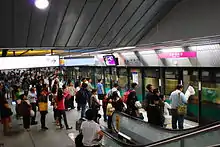
In August 2004, a section of subway tunnel near Sizihwan MRT station at the west end of the Orange line collapsed during construction due to loose sand underground and water break-ins. Four low-rise buildings near the collapsed tunnel had to be evacuated and later on had to be torn down due to major structure damages.[11]
The Kaohsiung MRT Foreign Workers Scandal, involving alleged inhumane treatment of Thai migrant workers, erupted in 2005. Investigation revealed kickbacks to politicians by the contractor. The scandal had tainted the public confidence in the construction of the system and prompted a diplomatic response by the Thai Prime Minister asking the migrant workers to return to Thailand. Chen Chu, the Chairperson of the Council of Labor Affairs of the Executive Yuan, resigned as a result of the scandal.[12]
In December 2005, another subway tunnel section of the Orange line at eastern Kaohsiung City collapsed during construction. The collapse of the subway tunnel also brought about the collapse of a road tunnel above the subway tunnel. Several nearby buildings were evacuated for several days for inspection. It was estimated that the road tunnel could not be rebuilt and reopened for traffic for at least a few months. In January 2008 the section was still closed and traffic is diverted around the affected area.
Opening
Construction accidents delayed the opening of the MRT considerably from the originally planned December 2006 date. The Sanduo-Siaogang section of the Red Line was eventually opened to the public for free test rides during 8–11 February 2008,[13] and the Red Line (except for 2 stations) opened for service on 9 March 2008.[14] The Orange Line fully opened for service on 14 September 2008.
Ridership
Ridership has been far below expectations, with an average of 100,000 passengers per day versus an expected 360,000, and accumulated losses are expected to reach NT$6 billion by the end of 2009.[15]
As of December 2013, the average daily ridership stands at about 178,975, with ridership figures significantly greater on weekends than on weekdays.[16] During New Year's Eve on 31 December 2012, the system transported 472,378 passengers.[17] KRTC stated that ridership would need to exceed 380,000 passengers per day in order to break even.[18]
Unopened Stations
The R1, R2, and O3 stations were planned originally but never built. The R1 and R2 stations were cancelled before construction, and the plan of O3 was abandoned after a fire in the nearby underground shopping mall.
Routes
.png.webp)
The MRT is made up of the Red Line and Orange Line with 37 stations covering a distance of 42.7 km (26.5 mi).[2] 27 of these stations are underground, with 8 elevated and 2 at-grade level. All underground stations have full height platform screen doors.
The light rail transit (LRT) system consists of the Circular Line with 14 stations and a length of 8.7 km (5.4 mi) with 1 elevated and 13 ground level.
- KRTS route table:
- In operation: Main lines: 3, Extensions: 0
- Planned: Main lines: 9, Extensions: 6
- Total routes: Main lines: 11, Extension: 6
- Terminated: Main line: 1, Extensions: 1
| Line | Termini (District) |
Stations[2] | Length[2] km |
Opening | Depot | |
|---|---|---|---|---|---|---|
| Red | Gangshan South (Gangshan) |
Siaogang (Siaogang) |
24 | 28.3 | 2008 | North South |
| Orange | Sizihwan (Gushan) |
Daliao (Daliao) |
14 | 14.4 | 2008 | Daliao |
| Circular | Rainbow Park (Lingya) |
Singlong Rd. (Gushan) |
23 | 12.8 | 2016 | Cianjhen |
Red line
.jpg.webp)
From the intersection of Yanhai and Hanmin Roads in the Siaogang District in the South, the Red Line travels northwards, following Jhongshan Road as it passes by Kaohsiung International Airport, Labour Park, Sanduo Shopping District, Central Park, and the Dagangpu circle to Kaohsiung main station. After crossing the track yard of TRA, the route then follows Bo'ai Road arriving at Zuoying. Then the route passes through Banpingshan, extends along Zuonan Road to Nanzih Export Processing Zone, and continues into parts of the city formerly part of Kaohsiung County. The route finally passes along the Gaonan Highway to Ciaotou District and the southern border area of Gangshan District. The total length of Red Line is approximately 28.3 kilometres, with 24 stations on the route, of which 15 are underground, 8 elevated and 1 at ground level. Two depots served the line with one near Caoya and Gangshan South. The Red line (excluding Gangshan South Station) commenced passenger service on 9 March 2008. Gangshan South station was opened for passenger service on 23 December 2012.
Orange line
From the west, the Orange line starts at Sizihwan (Linhai 2nd Road), crosses the track yard of TRA Kaohsiung Port Station and follows Dayong Road, passing through Love River. The route then follows Jhongjheng Road as it passes by Kaohsiung City Council, Dagangpu Circle, Cultural Center, Martial Arts Stadium, and the Weiwuying Park planning site before entering parts of the city formerly part of Kaohsiung County. The route continues along Zihyou Road, Guangyuan Road and Jhongshan East Road in Fengshan District to Daliao District. The total length of the line is approximately 14.4 kilometers, with 14 stations on the route. All stations are underground except Daliao Station, which is at ground level. A single depot has been built beside Daliao station to serve the line. The Orange Line commenced passenger service on 14 September 2008.
Circular light rail
The Circular LRT Line (aka Kaohsiung LRT, Kaohsiung Tram) for Kaohsiung City is a light rail line. Construction of Phase I, C1 Kaisyuan to C14 Sizhihwan began in June 2013. Phase I had operations on September 2017.
A temporary light rail system for demonstration purposes, with just 2 stations, was built in the Central Park in 2004, using Melbourne D2 Tram cars from Siemens. As it was simply for demonstration purposes, it was closed soon after, and is no longer operational.
Expansion projects
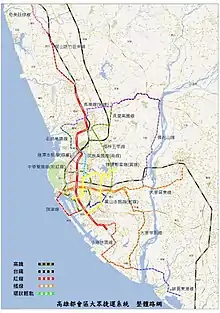
The Kaohsiung MRT is expected to be extended further into parts of Greater Kaohsiung, as well as Pingtung County.
Active projects
The Kaohsiung Underground Tunnel Project, extending from Baozhen Road, south of Zuoying Station, to Zhengyi Road, covers a distance of approximately 9.75 kilometers. Alongside a twin-track tunnel, it will construct five commuter stations—Fine Arts Museum, Gushan, Sankuaicuo, Minzu and National Science and Technology Museum —as well as move underground Kaohsiung Station (R11 Station of Kaohsiung MRT included). The Zuoying Project runs from the new Zuoying Station to Baozhen Road, a length of 4.13 kilometers, with the Neiwei and Zuoying stations to be moved underground. The Fengshan Project is the Kaohsiung project extension to Fengshan. It starts from the east of Dashun Overpass to Dazhi Overpass at Fengshan zone, covering a total length of about 4.3 kilometers. The project includes adding one new underground commuter station Zhengyi/Chengqing station and the Fengshan Station underground. The Duration for the project is from 2006 to 2018. In 2016, subsequent works are under way on stations, tunnels and rail tracks.
| Lines | Terminals | Length in km | Total Length | Status | Type | Depot | |
|---|---|---|---|---|---|---|---|
| Circular Line | Phase II (Main line) | Hamasen—Ersheng Rd. | 13.4 | 13.4 | Under construction | LRT | Cianjhen Agriculture 16 Yard |
| Red Line | Gangshan/Lujhu extension | Dahu-Gangshan South | 13.22 | 13.22 | Approved (Gangshan South to Gangshan) | Rapid transit |
North South |
| Yellow Line | Kaohsiung Exhibition Center-Niaosong | 21.2 | Planned | Rapid transit |
Niaosong | ||
| Cianjhen Senior High School-Niaosong | |||||||
All projects
| Lines | Terminals | Length in km | Total Length | Status | Type | Depot | |
|---|---|---|---|---|---|---|---|
| Red Line | Chimei extension | Chimei Museum-Dahu | 7.05 | 71.67 | Planned | Rapid transit | North South |
| Gangshan/Lujhu extension | Dahu-Gangshan South | 13.22 | Approved. Expected to be completed by 2027 [19] | ||||
| Main line | Gangshan South-Siaogang | 28.3 | In operation | ||||
| Linyuan extension | Siaogang—Linyuan Ind'l Park | 12.2 | Under evaluation | LRT | Linyuan[20] | ||
| Donggang extension | Wufang—Dapengwan | 10.9 | proposed | BRT | |||
| Orange Line | Main line | Sizihwan—Daliao | 14.4 | 43.07 | In operation | Rapid transit | Daliao |
| Daliao extension | Daliao—Linyuan | 14.67 | Proposed | BRT | |||
| Pingtung extension | Fongshan Jr. HS—Taisugar PT FTY | 14.0 | Approved by Executive Yuan | Rapid transit | Pingtung[21] | ||
| Circular Line | Phase I (Main line) | Lizihnei—Hamasen | 8.7 | 22.1 | In operation | LRT | Cianjhen Agriculture 16 Yard |
| Phase II (Main line) | Hamasen—Ersheng Rd. | 13.4 | Under construction | ||||
| Yanchao Line | Phase I (Main line) | Yuanjhong Harbor—Shu-Te Univ. | 12.78 | 23.17 | Revised | Yanchao OEM | |
| Phase II (Main line) | Shenshuei—Buddha Mem. Hall | 10.39 | Proposed | ||||
| Youchang Line | Main line | Zuoying—Yuanjhong Harbor | 6.4 | 6.4 | Proposed | BRT | |
| Yellow Line | Kaohsiung Exhibition Center-Niaosong | 21.2 | Planned | Rapid transit |
Niaosong | ||
| Cianjhen Senior High School-Niaosong | |||||||
| Fongshan Line | Main line | Ruixiang Jr. HS—Niaosong | 10.38 | 10.38 | Planned | ||
| Green Line | Main line | Wujia Ruilung—Houjing | 16.15 | 16.15 | Proposed | BRT | |
| Foguangshan Line | Main line | Siliao—Cable-Stayed Bridge | 16.06 | 16.06 | Proposed | ||
Rolling stock
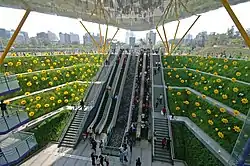
The rolling stock is based on the Siemens Modular Metro design manufactured by Siemens Mobility.[22] Trains run in 3 car sets (though platforms are designed to be able to accommodate up to 6 car sets, with the exception of Kaohsiung Main Station of only 3 car accommodations) and are powered by third rail. Seats are arranged parallel to the windows, unlike their Taipei Metro counterparts. LED displays are installed above every alternate door (other doors show the route map), showing the name of the current station and next station in Chinese and English. Automated announcements are made in Mandarin, Taiwanese (with the exception of Kaohsiung Arena Station since the Taiwanese translation for the name is not available), Hakka, and English, with Japanese announcements at the major stations. The train uses IGBT-VVVF traction motors powered by Siemens.
Fares and ticketing
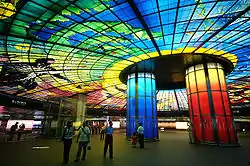
The fares of KMRT is distance-based, with a minimum of NT$20 for trips within 10 km. The maximum fare on Red Line is NT$60, from Siaogang Station to Ciaotou Station.
One way fare is ticketed with an RFID IC token. In addition to the RFID IC token, there are four kinds of contactless smart card are accepted by the system. The iPASS card was the only card that could be deducted before 1 July 2016. After 1 July 2016, EasyCard, iCash2.0, HappyCash are accepted by the system.
Ridership
Art
Kaohsiung Arena Station, Formosa Boulevard Station, and Kaohsiung International Airport Station feature artworks integrated into the design of the station by international artists.
Facilities and services
Platform screen doors were designed and supplied by Singapore's ST Electronics and has been installed at all underground stations. LCD television units have also been installed on platform doors for the broadcast of train information and advertisements. All stations are wheelchair accessible.
K.R.T. Girls
See also
Notes
References
- "History". krtco.com.tw. Retrieved 5 May 2017.
- "Introduction: Welcome to MBTU". Mass Rapid Transit Bureau, Kaohsiung City. Archived from the original on 2 March 2013. Retrieved 10 July 2014.
- "Mass Rapid Transit". stat.motc.gov.tw. Retrieved 18 February 2019.
- "Railways". Ministry of Transportation and Communications. Retrieved 16 January 2011.
- Staff writer (8 December 2007). "Kaohsiung firm apologizes for delay in opening MRT". Taipei Times. Retrieved 8 March 2008.
- Wang, Flora (8 March 2008). "Kaohsiung MRT art illuminated". Taipei Times. Retrieved 8 March 2008.
- "張揆主持高捷紅線首航通車典禮 (in Chinese)". Government Information Office 新聞局. 9 March 2008. Archived from the original on 30 November 2010. Retrieved 10 March 2008.
- Liu Chien-kuo, Chen Ting-fei, Kuan Bi-ling, Cheng Pao-chin (18 January 2017). "Language: A tool for messages or identity". Taipei Times. Retrieved 29 July 2019.
Since Taiwan’s Tongyong pinyin is closer to how English is actually pronounced and spoken around the world, — it uses “si” instead of “xi” — the new MRT line should use Tongyong pinyin. Kaohsiung’s MRT has used Tongyong pinyin for many years, yet foreign visitors and residents have no problem navigating the system.
CS1 maint: uses authors parameter (link) - KMRT History - Kaohsiung City Mass Rapid Transit Bureau official site (Traditional Chinese) Archived 2014-08-19 at the Wayback Machine
- "The Special Features And Prospect For Kaohsiung Rapid Transit System Project" (PDF). Retrieved 16 January 2011.
- "Construction halts on Kaohsiung Orange Line". The Taipei Times. 14 August 2004. p. 2.
- "Probe into Kaohsiung MRT project urged". Taiwan News. 5 October 2004. Archived from the original on 29 September 2007.
- "The China Post". The China Post. Retrieved 7 December 2017.
- 廖國雄 (10 March 2008). "高市/紅線通了 高捷公司允橘線8月通車 (in Chinese)". ETtoday. Retrieved 10 March 2008.
- "The China Post". The China Post. Retrieved 7 December 2017.
- "KRTC Transport Volume Statistics" (PDF). Kaohsiung Rapid Transit Corporation (via: http://www.krtco.com.tw/en/about_StatisticalData.aspx). 6 January 2013. Retrieved 10 July 2014. External link in
|publisher=(help) - "高雄捷運公司運量統計表" (PDF). Retrieved 7 December 2017.
- "Kaohsiung MRT predicts 11% rise in passenger traffic". Taipei Times. 4 January 2011. Retrieved 4 January 2011.
- https://www.taiwannews.com.tw/en/news/3039720
- 本機廠並未命名,位在林園區
- 本機廠並未命名,位在OP5站附近
- "Archived copy". Archived from the original on 16 February 2016. Retrieved 9 February 2016.CS1 maint: archived copy as title (link)
External links
| Wikimedia Commons has media related to Kaohsiung MRT. |